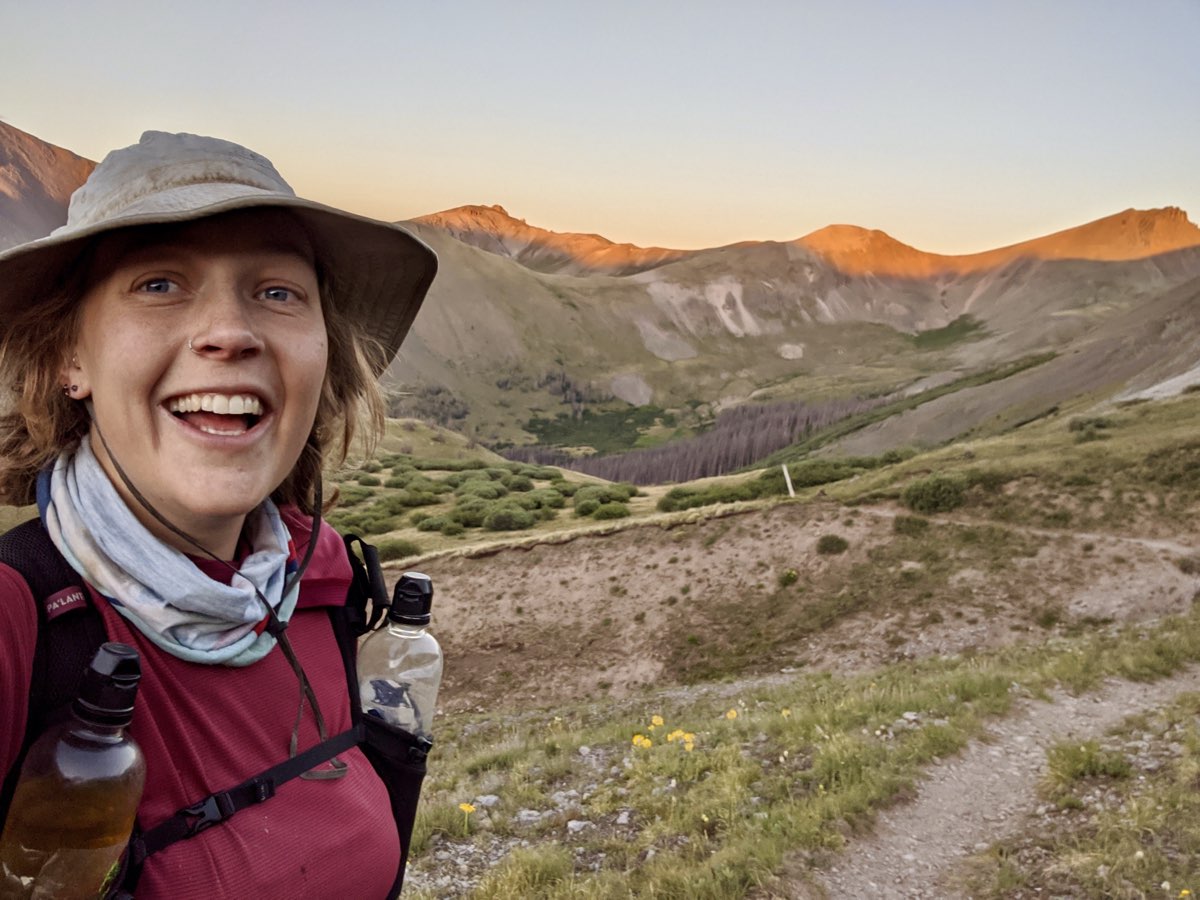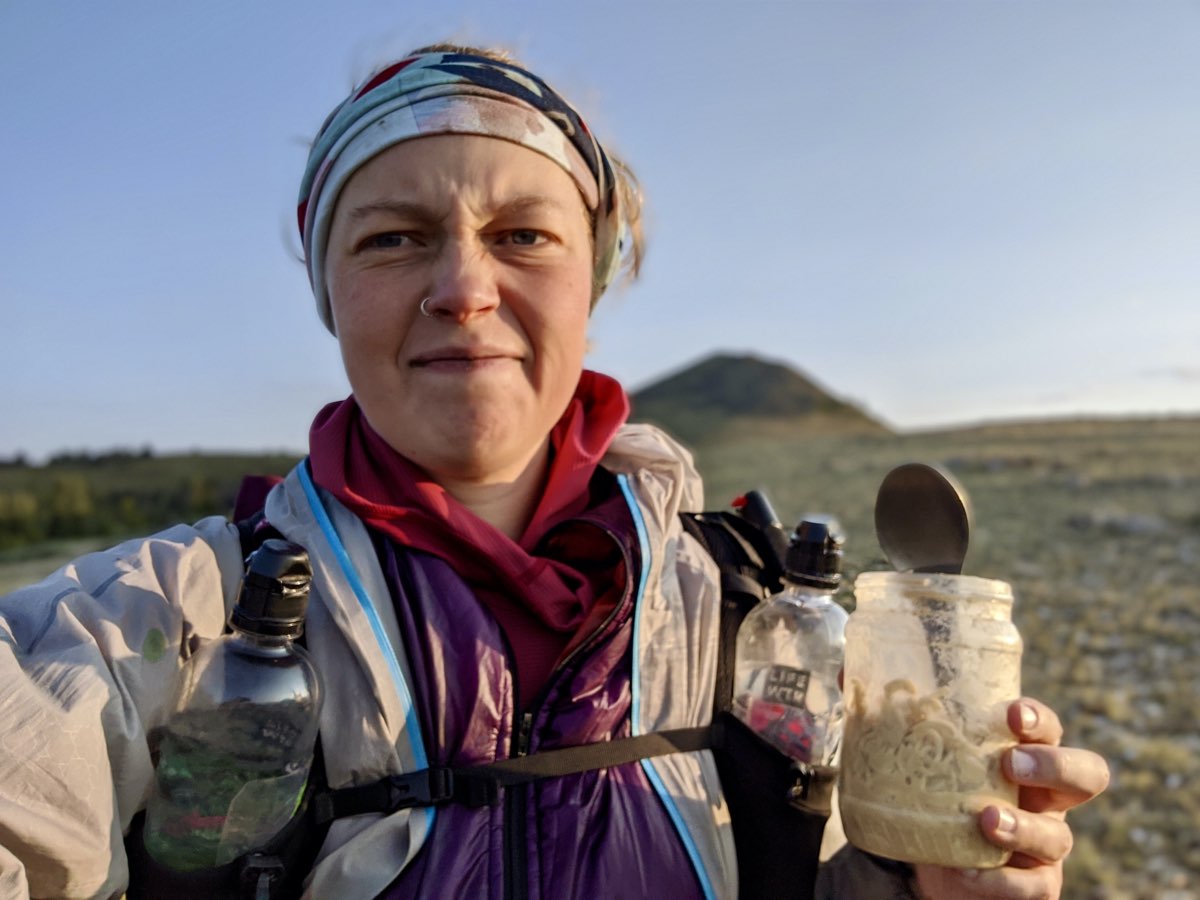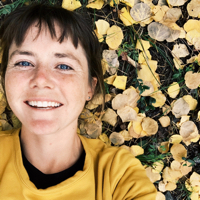Meet Mikaela Osler, also known as FlyBy in the thru-hiking world. She just set the new female self-supported fastest known time (FKT) on the Colorado Trail in a blazing 10 days, 12 hours, and 36 minutes. This bested the previous record, set by Olga King in 2018 at 15 days, 2 hours, and 28 minutes using the Collegiate East variation of the Colorado Trail. I had the pleasure to spend a rainy night out with Mikaela and her partner earlier this summer and let’s just say she made my pack instantly five pounds lighter by helping me to leave behind superfluous gear. By all definitions, Mikaela is a fastpacker, carrying little more than the essentials to travel far and fast by foot. Here is how she did it.
[Editor’s Note: On August 7 of this year, Marilyne Marchand-Gouin set a women’s self-supported FKT using the Collegiate West variation of the trail at 14 days, 13 hours, and 58 minutes. Since there’s a significant difference between taking the Collegiate East versus West variants, Mikaela and Marilyne’s records are different.]
iRunFar: I know you’re an avid thru-hiker. What got you into it and what other trails have you done?
Mikaela Osler: My dad did the Appalachian Trail when he was in his early twenties, so I grew up hearing about thru-hiking. I think part of me always knew I would do it. When I was in my sophomore year of college, things were really not going well for me–I felt pretty directionless and disconnected from myself. So in 2016 I took a yearlong leave of absence and hiked the Pacific Crest Trail. Since then, I’ve done the Continental Divide Trail in 2018 and the Appalachian Trail in 2019.
iRunFar: Have you always hiked big miles?
Osler: Yeah, more or less, although I didn’t really plan to starting out. My fourth day on the Pacific Crest Trail I realized I needed to do a 30 [miler] or I would be stuck in Warner Springs, California over the weekend waiting for my resupply package at the post office. And it felt amazing! I’d never really considered myself an athlete. I ran and played ice hockey in high school, but I was pretty bad at both, especially running. Our races were 5k’s and I would do them in 27 or 28 minutes. I’d never imagined my body could move 30 miles in one day. After that I was hooked.
iRunFar: What was your schedule like during your FKT? What time did you start and stop your day? How much were you sleeping? Did you stop much throughout the day?
Osler: I didn’t really follow a consistent schedule. Maybe I should have. Two of the nights, I slept close to six hours. Two of the nights I only did one or two of 15- to 45-minute naps. The rest of the nights were somewhere in between–usually around three or four hours of sleep. I’d listened to Stringbean [Joe McConaughy] on a podcast saying that on his Long Trail FKT he slept once at the beginning of the night for a few hours and once right before morning for a few hours, so I tried that out a few nights, with mixed results. I think I’m a little lazy and lost a lot of time waking up and getting moving, which made two sleeps slightly less efficient. But moving through the coldest part of the night does allow you to carry lighter gear. And I also had a plan that if there was ever a thunderstorm I was just going to sleep through it and then hike all night, but it never thundered so I didn’t get to execute on that.
I pretty much just hiked or ran the rest of the time. I stopped maybe once a day to mess with my feet because I had pretty gnarly blisters, but I tried to have my pack on my back and my feet in motion as much as possible. I did everything while I was moving–brushed my teeth, ate my ramen, updated social media, and more.
iRunFar: How much did you run in order to keep such a speedy pace?
Osler: Honestly, not as much as you’d think. I was so tired the first few days I hardly ran at all. After that, I ran roads or downhills. There were a few days where it might have been a third of the day or so, and a few days where I didn’t run at all. I tried to run as much as possible in the last 75-mile stretch from Molas Lake to Durango, because I was doing it without sleep and I just wanted it to be over, but about 10 miles before the end, when it was a long downhill and I should’ve been able to just run the whole thing, my quadriceps got seriously painful and I had to walk.
iRunFar: And did you get your trail name for being so fast?
Osler: Sort of. On that day on the Pacific Crest Trail when I decided to do a 30, I passed this guy while we were climbing on side-hill trail out of a wide, flat plain. A minute or two after I passed him, a fighter jet flew by us close to eye level–I guess they were doing training exercises in the desert. So the guy I’d passed said my [trail] name should be Flyby.
iRunFar: I hear you lost your sleeping pad? What did you do?
Osler: My sleeping pad was just a 1/8-inch-thick piece of closed-cell foam that stretched from my torso to my knees, so I was used to sleeping basically on the ground. Comfort and padding weren’t really an issue, but I was worried about warmth. I’d heard rumors about people forgoing sleeping pads to cut pack weight, so when I lost it, I reframed it in my mind as an opportunity to try that out. I think having experience on my other trails came in handy, because I knew how to look for a warm campsite. There are all sorts of microclimates as you walk through a landscape and if you play your cards right you can get a couple degrees of warmth by camping high, tucking under trees, and more. So I looked for warm spots, and I hiked through the coldest part of the night, and when I had to sleep I put my tarp and my poncho and even my sun hat into my pack and hoped it would insulate my torso a little bit. And the last 140 miles or so I didn’t sleep more than an hour or two at a time, so the pad wasn’t really that much of an issue.
iRunFar: Food. What did you eat?
Osler: I ate a lot of Clif bars and nut-butter packets. I had about one cold-soaked ramen with peanut butter every day, and a tortilla with cheese. I also had lots of Milano cookies and peanut-butter sandwich crackers. And honey buns! I wish I packed more honey buns. It was definitely a struggle to get myself to eat. First, I had some sort of reaction to all the sugar and my tongue got all bumpy and it was painful to eat for a couple of days. And after that, I had some pretty serious palette fatigue, and I was so tired that chewing felt like a huge effort. I got some Carnation Breakfast Essentials from the hiker box at Monarch Pass RV Park and for a few days I was making myself milkshakes with peanut butter, crackers, and cookies dissolved in them. They were pretty rich and sweet but at least I could get a bunch of calories down without chewing.
iRunFar: And your pack? How much did it weigh and what all did you carry?
Osler: My base weight (everything except food and water) was somewhere around 5.5 pounds. I mostly just carried the basics–a tiny tarp, quilt, and bivy, some rain gear, and a puffy jacket. I had a couple of luxury items, most of which turned out to be super useful. I carried an emergency poncho in addition to my rain gear and it worked great because I could put it on and take it off while I was moving. I also had fleece socks and some silk long johns for sleeping, which were really nice, especially once I lost my pad and was worried about staying warm. And I carried a bigger external battery than I normally do–10,000 MaH instead of 5,000–so I could be a little more flexible with charging time in towns.
iRunFar: Collegiate East or West? Why?
Osler: Collegiate East. I thought it would be faster, and I was worried about thunder on Collegiate West. Turns out Collegiate East is pretty boring, but I was able to move pretty quick, so that was nice.
iRunFar: What was your training like leading up to the Colorado Trail?
Osler: Not nearly as rigorous as it should have been! I was coming off of an iliotibial-band injury this spring, so I worked my way up to one 55-mile week of running, mostly on flat trail, and then tapered. I did some hiking on the weekends, too, but nothing hardcore. And I was at sea level for my stepsister’s wedding right before the trail, too, so I wasn’t acclimated. I’d started thru-hikes without a huge amount of training before, so I knew my body would probably figure itself out, but I definitely think I could have gone faster if I had prepared better.
iRunFar: How did your body hold up? Did you have any injuries or anything pop up that worried you?
Osler: Oh, yes. I had awful blisters, and since I wasn’t sleeping much and was wearing my shoes a lot, they started to get infected. My feet were just generally extremely swollen, which I should have known to expect, but for some reason I only got my shoes a half size too big instead of a full size or a size and a half, so things were pretty cramped in there. My knees were both pretty painful and started to swell as well, which has happened to me at the start of most of my thru-hikes. Usually I’d take a day off and ice them, but that wasn’t an option. I met a chiropractor on the Continental Divide Trail who taught me how to tape them to relieve some of the swelling, so I did that, and I just took a bunch of ibuprofen and muscled through it. And the first few days I had a lot of nosebleeds, and that weird thing happened with my tongue. My body was definitely freaking out a little bit. But by the end, actually, things were starting to feel normal and I was starting to feel strong. So that makes me a little curious about a longer FKT–like maybe I just went through the adjustment period and who knows what I’d be able to achieve afterward.
iRunFar: Any particularly memorable experiences?
Osler: I was really scared of the dark before this hike–I had trouble falling asleep whenever I camped alone because I was so certain something or someone was going to come and eat me or snatch me in the night, and I avoided night hiking at all costs. But I knew had to night hike to get the record. The times when I was hiking or running at night definitely stick out in my mind. I had a full moon a few days into the trip, and I was often moving above treeline, so I’d turn my headlamp onto the lowest setting and just walk by the light of the moon. I had the whole landscape to myself. Sometimes I’d see owls or bats swooping in the moonlight, but for the most part everything was completely still and silent.
The only time I saw someone else hiking at night was when I crossed paths with Courtney Dauwalter, who was doing a supported FKT attempt in the opposite direction. That was pretty memorable! I looked up and there were all these lights moving toward me. They had those powerful ultrarunning lights, not like my dinky ultralight headlamp. I was so surprised I screamed a little bit. She and her pacer were super encouraging and afterward I thought of all these clever and charming things I could’ve said but at the time I just talked about how sleep deprived I was.
And one other thing that stands out in my mind: one night I took a nap in the middle of the trail from 4 to 5:30 a.m. Usually that was no problem, because I was the first person to wake up, but at like 5:45 a.m. as I was waking up and putting my gear away, this woman came barreling down the trail! She had a backpacking pack, but she also was using a light belt, which I thought was kind of funny–was she an ultrarunner? I apologized, and she said it was no problem and that she’d camped in the trail plenty of times. The strange thing was that she had an accent, and I knew that the woman who had the record I was trying to break, Olga King, was Russian. But there was no way it could possibly be Olga, right? What would be the odds?
Well, a day later I had cell signal and I saw I had a message on Facebook from Olga–it was her! She stepped right over me!
iRunFar: I hear you’ve gotten into ultrarunning a little bit? Do you have any races or routes that you’re itching to run?
Osler: I’ve never done a mountain 100 miler before, so I’d love to do one, but it’s hard to know when they’ll be an option again. And after all this sleep deprivation, I’m really interested in trying out a backyard ultra. I used to think I wouldn’t be able to make it beyond 24 hours without sleep, but honestly compared to what I just did, running four miles per hour on something relatively flat with aid every hour, other runners on the course with you, and a crew to take care of you sounds extremely pleasant.
iRunFar: Outside of crushing miles, what do you do?
Osler: I’m a writer. I’m in my second year of a Master of Fine Arts in creative nonfiction at the University of New Mexico.
iRunFar: And, of course, what’s next?!
Osler: That sucked so much I’m going to need at least a few months before I start to think about another project. But I’m pretty sure that whatever I go for next I’m going to try for an overall record rather than a women’s record. I frankly don’t think there was anything about either my sex or my gender that slowed me down, so it feels a little bit like I got a weird consolation prize. Obviously I pushed myself, but I feel like I could have pushed myself harder if I was trying to compete with men. So that’s what I’m going to do in the future.




